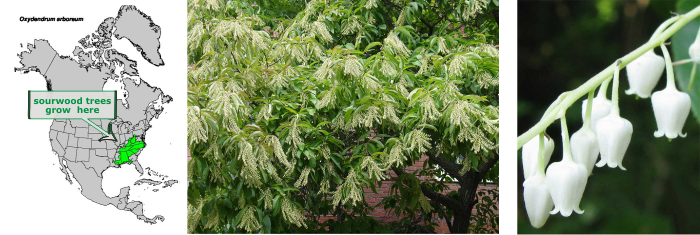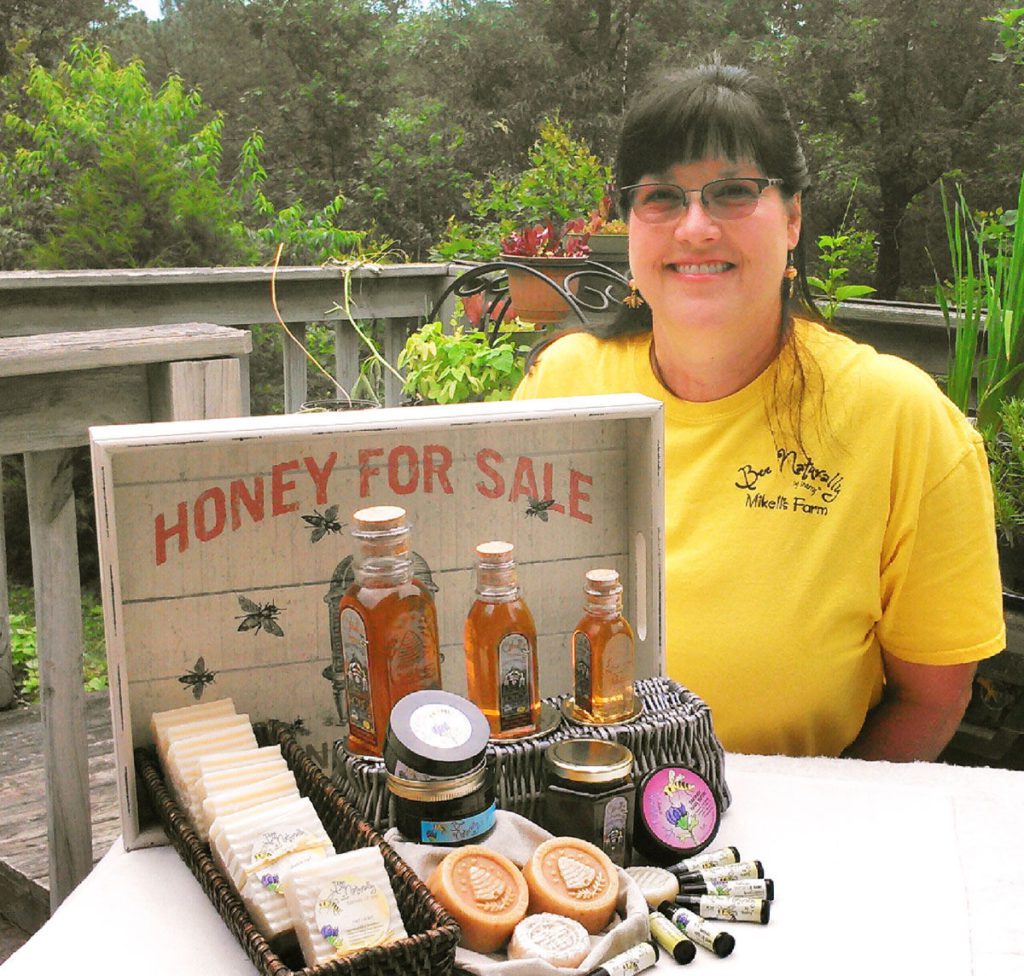Sourwood honey is one of the three most famous honeys in America: sourwood, gallberry and tupelo honeys. It won “The Best Honey in The World” twice, in 2005 and 2007, at the prestigious Apimondia World Honey Show, a bi-annual world conference for beekeepers and the honey. Americans always say “When it comes to quality and taste, no other honey can match Sourwood Honey.”
Name: Sourwood (the name comes from ” sour”, which describes the sharp acid odor of the leaves, due to their oxalic acid.)
Also known as: Sorrel tree, Lily-of-the-Valley tree, Appalachian Lily tree, Sour gum [Sour gum is a local name for both Nyssa sylvatica (Tupelo) and Oxydendrum arboreum (Sourwood)]
Botanical name: Oxydendrum arboreum (the name comes from oxy – meaning “acid” and dendrum meaning “tree”)
Genus: Oxydendrum, sourwood is the lone species of its genera. Family: Ericaceae
Location: Native to North America, from southern Pennsylvania south to northwest Florida and west to southern Illinois. It is most common in the rocky wooded slopes of the Appalachian Mountains. 1
Characteristics:
Sourwood is a small tree (or large shrub), growing up to 10–20 m (33–66 ft) tall, with a trunk up to 50 cm (20 in) diameter.
It often grows in combination with azaleas and rhododendrons, all preferring the same acidic soil.
The bark on mature trees is gray, fissured, ridged and scaly.
The leaves are dark green in summer and crimson red in fall. Leaves have a sour taste, hence the common name. They are heavily charged with acid, and to some extent have the poise of those of the peach. The leaves are also a laxative.
The blossom appears in mid June and lasts till late July, developing clusters of sweet smelling white, bell-shaped flowers, called “angel fingers” in the Appalachians, having a a slight fragrance. They are 6–9 mm ( 1/4 to 1/3 inch) long, produced on 15–25 cm (5.9–9.8 in) long panicles. The fruit is a small woody capsule.
The flowers are quite attractive to bees. And there are years (pretty rare, it’s true) when the weather conditions are so favorable that nectar is so abundant that it can be shaken from the blooms in small drops. But the usual situation is when beekeepers make a great crop one year, and nothing in the next one.

How is sourwood honey
Taste: sweet, rich and full, with subtle notes of caramel and anise with hints of maple and spice. No, it is not sour! 🙂
Flavor: mild, floral and light with hints of baking spices and anise.3
Color: light (sometimes pure white) to medium, with lavender hues that slowly darken to a dusky straw color as it ages.2
Aftertaste: spicy, gingerbread twang4
Crystallization: slow
Characteristics of Malaysian sourwood honey, according to a 2013 study (ref.6):
Phenols content: 580.03 ± 0.38 mggalic acid/kg (this contest was the highest when compared to manuka, gelam, longan and rubber tree)
Flavonoids: 156.82 ± 0.47 mgcatechin/kg
Radical scavenging activity: 59.26 ± 3.77% (very high)
Ferric reducing power: 648.25 ± 0.90 μM Fe (II)/100 g

Sourwood honey is one popular type of honey that is produced in Eastern United States, especially in Western Carolina, Virginia, Tennessee and North Georgia. Yet sourwood honey is so rare that a good crop sometimes appear only once every decade!
And here is why:
– lack of habitat, with currently very small amount of sourwood trees growing, constantly threatened by development.
– poor environmental conditions;
– the bloom season is very sensitive to rainfall
– trees need adequate sunlight in order to produce nectar – which is difficult because sourwood trees are often shorter than the tress that surround them
– if the blooming is not good, honey bees will harvest nectar from other sources and thus the resulting honey will not be pure sourwood, but a multifloral one.
– the timing of bringing the hives should be perfect. Because they bloom later in the year, after most of the wildflowers, maple and tulip blooms, there is a narrow 3-4 week window where beekeepers can harvest this rare nectar. If beekeepers bring the hives sooner, the bees will collect nectar from other sources (like sumac trees, as they bloom right before the sourwood) and the honey will not be pure (monofloral).
“Many honey connoisseurs today agree that Sourwood is the best tasting honey available. Its syrupy, spicy flavor is impossible to find in other varieties. Furthermore, its limited region, season, and supply make it a rare treat and a regional specialty prized for its true distinctiveness.” (slowfoodusa.org)
The best sourwood honey?
 There is a contest held in Asheville, NC, U.S.A., that can say what is the best sourwood honey.
There is a contest held in Asheville, NC, U.S.A., that can say what is the best sourwood honey.
The International Black Jar Honey Contest reached its 7th Annual International edition and in February 2017. 40 judges with varying backgrounds of CEOs, business owners, executives, and more wearing homemade antennae had judged over 40 different kinds of honey from as far away as Kansas and Alaska. And they chose its
2016 -2017 International Black Jar Honey Contest Winner at Sourwood Category and 89% Certified Sourwood Honey:
Mikell’s Farm Honey, owned by Sharry and Doug Mikell of Old Fort,
They won his contest twice: the 2014-2015 and 2016-2017 Sourwood category of sourwood honey.
If you want to convince yourselves, try their honey. Buy it directly from their website.
Sourwood honey health benefits:

Malaysian sourwood honey has a higher antioxidant power than manuka honey has!
It is well known that the darker a honey is, the most powerful antioxidant activity it has. But sourwood and arbutus honey from southern Europe make the exception. At least the sourwood honey from Malaysia, as the study was made using samples from that region.
Other honeys with high antioxidant powers, in decreasing order: buckwheat (Fagopyrum sp.), Chinese milk vetch (Astragalus adsurgens), Heather (Caluna vulgaris, Erica umbellata), Honeydew (all types of honeydew honeys), Manuka (Leptospermum Scoparium), Strawberry tree honey (Arbutus menziesii), Sweet chestnut (Castanea sativa), Tualang (Koompassia excelsa), Ceratonia, Peppermint.6
Drink a switchell
In the Appalachians, there is a drink for hot summer haymaking days called “switchell” It is made by mixing a half cup of honey and a half cup of cider vinegar. This is kept in a jar and four teaspoons of the mixture are added to a dipper of water for a refreshing drink. 5
Sourwood Festival
Every August, Black Mountain, North Carolina hosts the Sourwood Festival. The Sourwood Festival celebrates the beautiful Appalachian native Sourwood tree, and the delicious, unparalleled honey. Hundreds of vendors and families attend the festival, which has everything from music and dancing to arts and face painting. You are sure to find here some of the locals’ praise-worthy Sourwood Honey.
Where can I buy sourwood honey from?
• Amazon.com sells Raw Sourwood Honey (Pure Natural Honey), and there are many other brands available;
• Mikells Farm, the winners of the black jar Contest, sell it on their website www.MikellsFarmHoney.com.
• BlueRidgeHoneyCompany.com of a very good quality;
• Carolina Honeybees, a small sustainable Honeybee Farm.
References and pictures credits:
“sourwood blossom” – from featured picture – credit Mrs. Gemstone via flickr.com, under CC;
“Atlas of United States Trees” – By Elbert L. Little, Jr. / U.S. Geological Survey [Public domain], via Wikimedia Commons;
“sourwood tree” by geneva_wirth, via flickr.com under CC;
“Flowers of the Sourwood or Sorrel Tree” By Jim Conrad [Public domain], via Wikimedia Commons
1en.wikipedia.org;
2 savannahbee.com;
3 slowfoodusa.org;
4 http://heritagefoodsusa.com/blog/sourwood-honey/
5 http://www.honeytraveler.com/single-flower-honey/sourwood-honey/
6 MONIRUZZAMAN, M; SULAIMAN, S A; KHALIL, M I; GAN, S H (2013) Evaluation of physicochemical
and antioxidant properties of sourwood and other Malaysian honeys: a comparison with manuka
honey. Chemistry Central Journal 7
http://www.mcdowellnews.com/news/mikell-s-farm-honey-twice-wins-international-contests/article_806e2530-f227-11e6-9b3f-7f4fcf802be3.html
http://www.mtnhoney.com/types_honey.htm;
http://www.missouribotanicalgarden.org/PlantFinder/PlantFinderDetails.aspx?kempercode=a887;
ashevillebeecharmer.com
